‘it wakes you up in the morning with a cup full of piss in your face, slaps you about the chops to make sure you’re awake enough so it can kick you in the bollocks.’
Malcolm Tucker, The Thick of It
Mr Tucker may well have been talking about his job as a spin-doctor for the British Labour Party. But, for me, he might as well have been talking about the Monaro Cloudride (CR), a non-stop mountain bike race from Canberra through the Snowy Mountains and everywhere in between. Like most Cloudriders, I observed the event via Spot Tracker for a few years before finally deciding to tackle the great beast. But the first time I heard about the event, I loved the idea. It seemed so preposterous, so likely to end in heartbreak, that I decided I would have to have a go. In April 2017, I joined 22 other riders on the start line. Nine days and a thousand kilometres later, I finally crossed the finish line. Here’s how I did it.
The first three editions of the CR were brutal wars of attrition. Only half of those who start made it to the finish. If the weather turned, it was even worse. So, it was pretty clear that my year was unlikely to be any different. I did, however, observe some common trends among those who didn’t make it (and those who did). I’ve attempted to weave these observations into this account of my experience of the 2017 CR.
First, a warning. This is not a guide for how to “win” the Cloudride. That way, madness lies, my friends! This blog is to help you “finish” the Cloudride in a respectable time, a very different goal.

Ok. Let’s get the technical stuff out of the way. (I’ve put a gear review at the end of the blog.)
Bike: Specialized Carve Pro 29er, hardtail, carbon chisel front-fork, XTR wheelset, tubeless tyres (Rubina Kratos. 2.4).
Gears: XT, front chainrings 44/32; rear cassette 12/36.
Brakes: Gemini Tektro, kevlar pads.
Bike bags: Revelate Design
Tent: Mountain Hardware Ghost 1-person. About 900grams.
Sleeping system: Sea 2 Summit: ‘Traveller’ sleeping bag; thermo-lite ‘Reactor’; thermorest.
Food: gas burner and small fuel canister, dehydrated meals.
Clothes: 1 x riding shorts, 2 pairs of knicks; 2 jerseys; leg warmers, puffer jacket, Gore-Tex rain jacket (Mountain Design).
Other stuff: Squirt chamois cream, toilet roll.
Water: 2 x 750ml bottles, 2 litre water bladder in frame bag, plus plastic container for another 1 litre. Purification tablets.
Lights: Ayup: bike and helmet mount. Charger.
Spare: Various spares and tubes, including kevlar replacement spokes. (Note: I didn’t carry a spare tyre. Instead, I had enough stuff to repair or boot a damaged tyre).
Navigation: Etrex 20; iphone and ridewithgps premium membership as backup.
I like tweaking and fussing about with gear as much as anyone, but I do so with full awareness that such pedantry will not help you complete the Cloudride. For me, the psychological benefit of being prepared brings a confidence that far exceeds any benefit of lightness and extra speed. Fully loaded, this set up was about 26kgs. A beast, I know, but I wasn’t interested in winning. I wanted be able to comfortably pitch camp anywhere and see out any weather event. Plus, I love the idea of a self-sufficient rig, and I really, really don’t wanna be the guy calling for rescue because I was worried about a few extra kilograms.
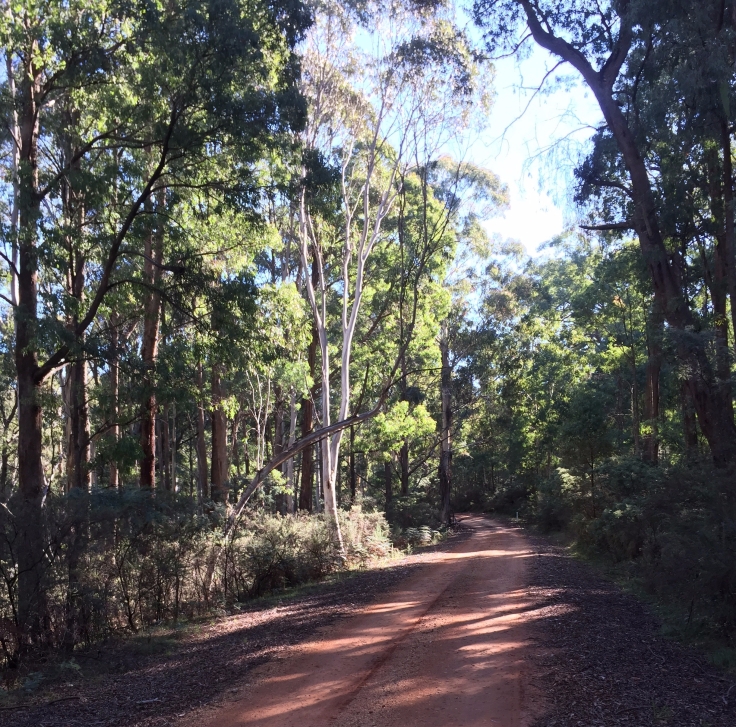
Fitness is over-rated
Sure, fitness helps, but very few riders have failed to complete the CR because they weren’t fit enough. Strength and perseverance are probably more important, but more on that later.
My preparation focused on strength and being able to pedal my bastard, heavy bike for hours on end. Six months out I attached a three-kilo tent to the front of my mountain bike which became by commuter bike. I also rode plenty of hills with packed seat bags and lots of water. Not close to the battle weight of 26 kg, but enough to toughen the sinews and the soul.
In September 2016, I spent three weeks riding the 1,000 kilometer Munda Biddi trail in Western Australia. (Do it if you get a chance, it is fantastic). Nothing builds strength like pushing a touring load. This was too early for it to be useful CR training, but it was a good field test of my set up. After this I rode a 200km Audax brevet every month and completed a tough 600km brevet in early March.
Don’t start tired
Ten days before the start I rode another 200km Audax brevet, this time on my mountain bike. I must confess that I did not take my tent! A shameful act of softness, I know. From then on, I did very little at all. It paid off. Come race day, I covered the 155km to Tumut at about 17 kmph. Given the weight of the bike and the hilly terrain (over 3,000 vm), this surprised me. I actually held back. I saved my matches for another day and let the leaders and the wannabes spend their energy early.
There were plenty of jitters, crashes and nervous riding on display on day one. Some riders were sprinting for lights in Civic. Crazy. It’s exciting, yes. You might be left behind, also true. But you’ll probably see half the people in front of you again, at some stage.
Descending Argalong Rd into Tumut was a highlight. I had ridden well. I felt good And the view in the twilight was glorious.
Shit Happens
The CR is a solo event, but teaming up enroute has its advantages. The high-country can be an intimidating place and having another rider with whom to share the journey can bring a lot of confidence. However, due to the demanding nature of the event and of the vagaries of endurance riding, you may not have your new riding buddy for long. I rode with a few different people on the first day, both of whom pulled out soon after. (It was nothing personal, I’m sure.)
On day two, as I rode out from Tumut, I met Paul. With similar riding styles, fitness levels and a shared ride strategy, we were a good match. We would spend the next three days riding together.

After passing through Batlow we stayed at McPhersons Alpine Plains Retreat on Elliot Way. It sounds glamourous. But it was not. In fact, when we arrived we rode past an ambulance which, we later learned, was carrying a boy who had been accidentally stabbed during a game. It was cold and it had been a long day so we were grateful for the basic shelter. Pork rolls was the only sustenance on offer so that was dinner and breakfast sorted. Or so I thought.


That night and the next day I had diarrhea. Not fun on a bike ride. And the terrain was getting mean. The riding into the KNP and up to Cabramurra is tough and includes the first of the real hike-a-bike sections. I held it together until we had a good feed at the bistro. After that I couldn’t ride more than five-kilometres or so without a dash into the scrub — trees were getting harder to find.
I had a foolhardy plan to ride 125 kilometres that day; we ended up doing 80. After dark, I realised that I was very cold, empty and utterly spent. Ten-kilometers out from Happy Jack’s hut I told Paul that I was done. I couldn’t go on. After what seemed like an eternity, we found the turn and rode a couple of kilometres to the hut. We were lucky to find the hut occupied by Tegan and Tom, the fire was blazing and they offered us hot tea. Such a relief! We slept inside. It was a sub-zero night. (T and T were a month or so into their plan to ride the entire length of the Bicentennial National Trail. Check out their incredible adventure here.
Here, the early call was important and meant we avoided a very cold and uncomfortable night. Not telling someone your feeling rough as early as possible might be noble, but it is rarely wise.
A tiger snake does not care if you have a Strava KOM/QOM
The next day, I felt a lot better. And it was mere 80 kilometers to Jindabyne. That mere 80 kms took 10 hours. Along the way, this happened.
The sight of a snake rearing up, hissing, and preparing to strike is motivating. When Paul alerted me to this danger at my feet just after I had crossed a small stream, I was sufficiently motivated to leap, gazelle-style (but with less grace) back across the water. The snake, on the other hand, wasn’t going anywhere. Rocks and harsh language made little difference. A few minutes went by. There was no clear way around this guardian of the crossing, certainly not one that avoided scrambling through ever better snake habitat. Luckily, the snake grew weary of our interference and moved slowly away. We crossed gingerly and rode on. Over the next hour I imagined every stick and shadow was a snake.
Quite sensibly, our scaly friends like sun-baking out of the wind near water. Take care: if you get chomped out there it’s helicopter time.

In addition to delays caused by our wildlife encounters, the terrain is remorseless. Paul’s new brake pads dissolved under the pressure, which made descending out of the KNP an unnerving and dangerous experience. Bike shop workers like to recommend organic compound brakes. They may bed in quickly and quietly, but the CR will eat them for breakfast. I rode with kevlar pads. Yes, you will hear me squealin’, but the bike stops in all weather. A year later and I’m still on the same set of pads.
In Jindabyne we stayed at the Kookaburra Ski Lodge. This place is great. The owners love bike riders and will cook your free breakfast at a time of your choosing. We enjoyed the pub grub at Banjo Patterson Inn. It’s rare when a massive chicken parma and chips, two cokes and a mars bar cheese-cake, isn’t an excessive amount of calories.
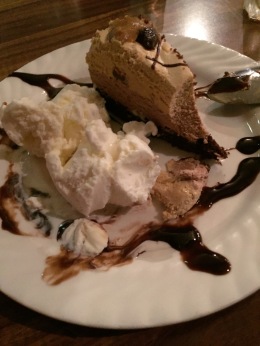
Here I go again on my own
When Paul made the tough decision to stop his ride, I left Jindabyne feeling more vulnerable than I ever had on the journey so far. I felt bad for him. It takes courage to quit a big event, however compelling the reasons. More selfishly, I had also lost my riding partner on what I knew was going to be (another) epic day on the bike. Worse, now I only had the wildlife to complain to.
It also takes good judgement to know when (and where) to stop. Think about this. Calling for rescue may be unavoidable, but if you really think you can’t make the next section, stop. Have a meal and a sleep. Then reassess. Think long term. Taking a whole day off might seem like an eternity, but if that’s the difference between a DNF and continuing with fresh energy, then the choice is obvious. You’ve come this far, after all. But sometimes that decision is made for you, and to continue would be folly.
Of course, the heavy veil of fatigue will render these decisions far from obvious at the time.

Remember where you are
I spent too long crossing the Snowy River. The water was flowing pretty well so I made two trips. The first was a scouting mission with some of my gear. The second was with my bike. Had a few hairy moments in the faster currents, but arrived safely on the other side I filled up and treated my water supply. I had about six liters. Shit, the bike was heavy!

Up I went. The first kilometres wasn’t too bad. “What was Steve (ride organizer) going on about”, I thought. Then, I looked at the profile view on GPS. Oh my giddy fuck! This was mountain climbing, with the added joy of an overloaded bike. I had ten more kilometers to go before I reached the summit.
And, so, the work really began.
Narrow ‘benches’ have been cut across the slope every 50 meters or so, designed to divert water and help maintain the trails. For the hapless mountain biker they provide the briefest chance for a rest. However, these cuts create an even steeper ‘lip’ immediately before the bench. The only advantage of my heavy bike was that when I locked the brakes, I could use it as an anchor to haul myself upwards. I scrapped a footing, stepped in and thrust the bike forward. Lock the brakes. Scrape another footing. Push the bike up. Repeat. Repeat. Repeat.
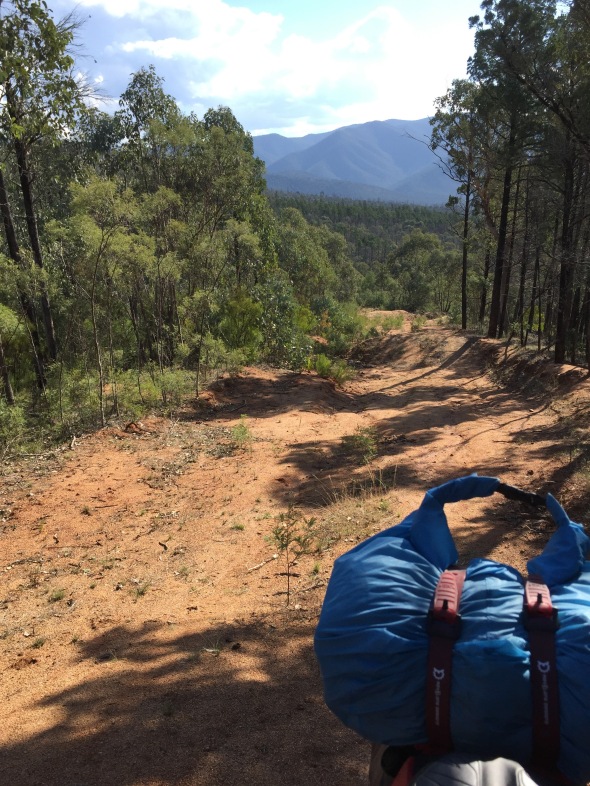
After half an hour of this, I became so demoralized I decided to mentally break the climb into ten sections. I then worked to finish each section without stopping. As I pushed I stared at the GPS trip meter, praying for it to tick over. After each kilometre, I rewarded myself with a short break, some food and water.
A storm brewed. It was hot and humid. I was bucketing sweat. By the top, I needed all my strength to get the bike over the lip to the water bars. It had been four hours of hell. The view, however, was awesome. The storm drew closer. There was time to take a quick photo, but that’s all. Lightning flashes were becoming brighter more frequent.

Spurred on by the pounding electrical storm that now swirled around me, I wanted to get off the mountain fast. Contrary to very sound advice, I then rode down the other side which was just as steep as the climb.
It was very nearly a disaster. With the weight of the bike pitched forward, the slightest over use of the front brake de-weighted the rear of the bike, which would then swing wildly to the right or left, very nearly causing me to crash. I found I could only arrest this violent pendulum motion, by squatting on the top tube until I got the bike under control. Frightening. Slow down. Yes, remember where you are. This became my CR mantra.
I found that walking was not much safer. So, I squatted on the top tube to lower my centre of gravity and skidded my way down.
As part of your training, it is worth practicing your hike-a-bike technique. Full-dress rehearsal, required. Load up (no squibbing!), find a steep, rocky and un-rideable slope and push up in the manner described above. Remember, it’s good for you! Don’t take your best shoes. I still have holes in the toes of mine as a memento of this ordeal!
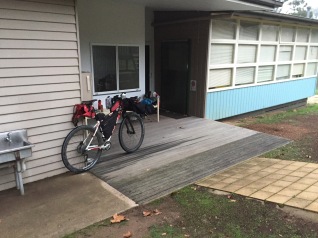
Dumb things
I suffered a major attack of dumbness as I raced away from the storm towards shelter at Tubbut. The droplets had started, but I was determined to outrun the rain. Only 10 kilometers to go. I gunned it. The droplets got bigger and bigger, then they started to hurt! Then it bucketed down with such intensity that I was completely drenched within seconds. I arrived to a deserted town and couldn’t get into the local hall. With no way to dry anything, I had to carry a bag of wet, heavy gear the next day. All could have been avoided had I just stopped before the rain to put on my rain gear! I put it down to a fatigue-induced error of judgement.
An earlier attack I forgot to mention occurred way back in Tumut. I got up early to get some breakfast (a pie) and my some lunch (ham rolls). A little too eager to get moving, I took a big swig of my coffee. It was scalding. So hot, in fact, that I burnt the roof of my mouth with enough severity to cause it to bleed. The real kicker came over the next few days. Every mouthful of food thereafter was very painful. Given how much I needed to be eating, this rated as one of the most foolish errors of my ride. This is not printed on the established list of likely CR risks!
Hurry up and wait
I love stopping. It is one of the reasons I ride. I get to interesting places, stop, and enjoy the view, a coffee, a snack, whatever. Mostly, this doesn’t matter. But on the Cloudride the equation was simple. Every minute stopped equaled a minute more of night riding. I wasn’t obsessive about it and a little night riding can be quite nice. But at night, everything gets tougher. You’re tired, cold and hungry. Risks are amplified.
When the sun goes down the place really starts jumpin’. Wildlife is one of the obvious risks on the CR: wombats, roos, brumbies and deer are common obstacles. A less obvious danger came from the livestock I met as I moved through various pockets of private property. I had a couple of very close encounters with agitated cattle, terrified at the strange illuminated figure on a bicycle. Sometimes I stopped, got off my bike, took of my helmet and had a chat to these creatures. More often than not, they soon realized that I was not an alien life form and relaxed enough for me to pass by.

Your wretched body
‘Endurance riding changes the shape of your body’.
I wish I had come up with that simple, vivid image, but I didn’t. Mike Hall did. Alas, I only heard him say it in a Youtube film after I had finished the CR.
Fifteen years of endurance riding and my Achilles tendons have never protested. Not a murmur. Nothing. After five days on the CR and I was in real trouble. On the sixth day, I pedalled along expecting to hear the awful sound of a snapping tendon, finally bringing my ride to an end.
In his video, Mike emphasised the importance of continually monitoring and adjusting your bike set up as you go. I had made some adjustments to my seat height, but it was too little, too late. I found a somewhat ungainly riding position that relieved some of the strain. I essentially rode the last 400 kilometers dosed up on anti-inflammatory drugs and with only one leg providing any real power on the climbs. When that leg got tired, I walked.
The final countdown
My last day on the CR came with mixed emotions. I watched my last sunset knowing that a very demanding, intense and rewarding experience was coming to an end. I rode on through Kowen Forest. Encountering Canberra traffic again was annoying. My CR bubble had well and truly been burst. Just after Malcolm Fraser Bridge I was greeted by Alex, a mate who had been watching the tracker and decided to escort me to the finish.
There I was: sore Achilles, sore hands and sore backside. I had holes in my shoes. I had gorged on trucker-sized meals at every opportunity, yet I still finished three-kilograms lighter.
Then, we were back in Braddon. Someone gave me a beer.
So, would I do it again?
In a heartbeat. Invigorating. Exhausting. Thrilling. Brutally challenging. The Cloud Ride is among the best rides I’ve ever done.

Postscript and gear assessment
I’m an Audax rider. I’m use to long rides with no support in dodgy weather. I plan for the apocalypse. On my CR I had good weather, but I still encountered sub-zero nights, a massive thunderstorm, heavy rain and some very hot days. Be prepared.
With a lot of rest, my Achilles took months to heal properly. No doubt this will be another thing to manage much more actively in the future.
- I wore every item of clothing, so no major excess to trim there.
- I really enjoyed being able to cook up my own meals, and happily incurred the weight penalty. Next time I will carry less water, as there is plenty available enroute.
- My sleep system is well tested and I’ll be sticking with it for non-winter adventures.
- The lack of suspension hurt. Some of the roads are shockers and my body took a beating, especially my hands. Bigger tyre volume might help, but I’d seriously consider some front suspension next time.
- Lights: the Ayups were awesome but charging was a pain. Next time I’ll go for a dynamo hub to run lights and charge my phone on the move. It’s one less thing to fuss about when you are resupplying and just want to get a feed and get to bed. You’ll still need a head torch for scanning for wildlife. You’ll also need light when you stop to set up camp or fix your bike.
- More camping: next time I will try and push on to some of the great forests I passed through. Eg. Tantawangalo Mountain, Tallaganda
- Next time, I will pack some cheap flip flops for the numerous water crossings. Wet shoes are manageable, but wet feet encourage blisters and are bloody cold!
- Ditch the stiff mountain bike shoes. Will still ride cleats, but on a rubber soled shoe which are much more comfortable for the hike-a-bike sections.

Unfortunately, I can’t tackle the CR again this year. I’ll be busy with work and promoting my new book about one of Australia’s greatest ever cyclists, Hubert ‘Oppy’ Opperman. Read more about that here.
Good luck, Cloud Riders, good luck!
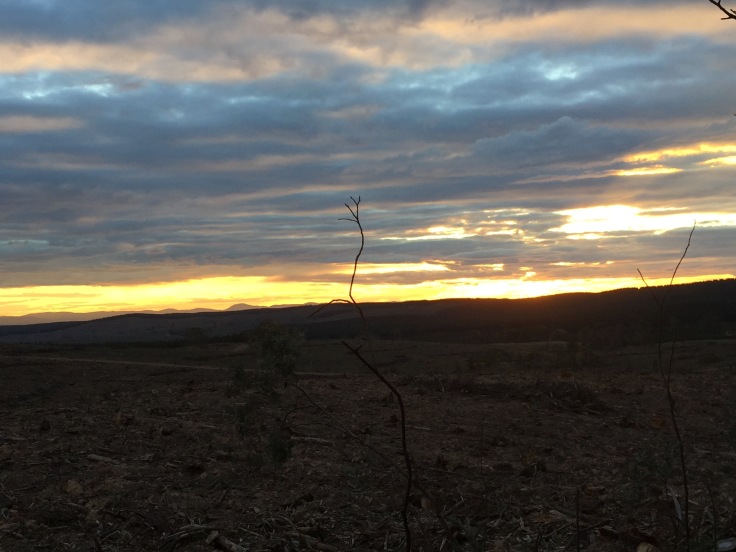
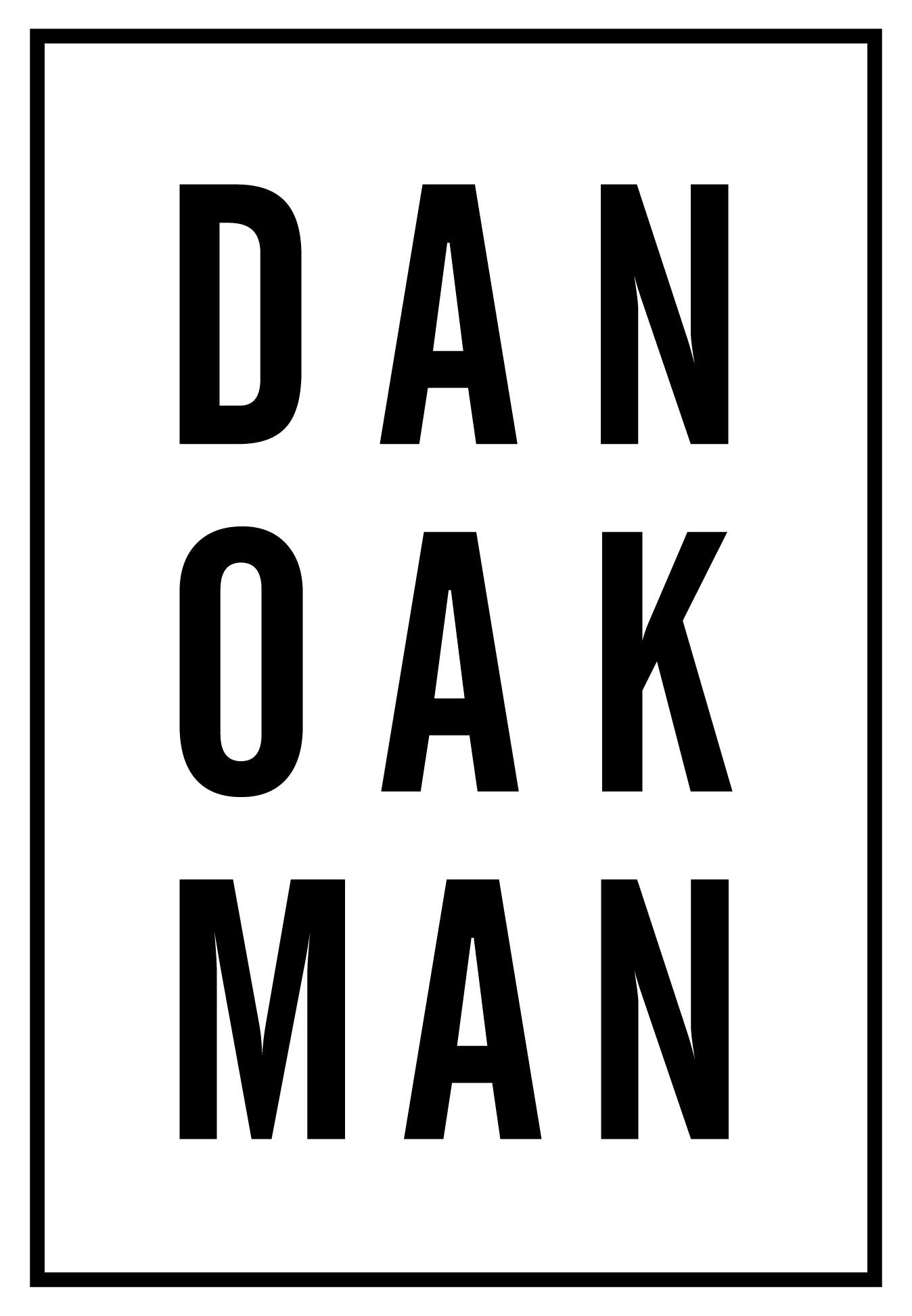









Excellent post Dan, small and quick questions, compared to the Munda Biddi, how do you rate the CR from toughness POV , I’ve managed to do the MB in 9days on a similar setup as yours but in a 1x (40t/11-42t) gearing , do U reckon that should be good enough for the CR or I should think about a 33/34t front as many had advised me, u said there r good amount of water source , u reckon 2x 1l bottle and a 2l balder(only used on big dry legs) should be enough?
LikeLiked by 1 person
Thanks for reading, Mack. Hope it helps. I took a bit longer on the Munda Biddi, so I wasn’t working nearly as hard. As you know there is plenty of climbing on the MB, the difference on the CR is the gradient and the track surface. Pea gravel aside, the MB trails are pretty nice. The high country sections of the CR are much rougher and steeper. The rest is very similar to the MB in terms of difficulty and style. There were times when I felt I was doing the MB again!
Your 40/42 gearing is (according to my gear ratio calculator) about the same as mine. I don’t think more gear would have helped me. For me, once I’m below 4 kmph with a heavy load its gets hard to balance on the rougher surfaces, so the super low gearing doesn’t help. More talented riders than me, might disagree, and that’s cool. But at those low speeds, I used less energy walking. And I got to rest my butt!
Your water plan is exactly what I would do next time. I mean, check the weather and recent rains, and take purification tabs, but that will be plenty.
Sounds like you are ready!! Have a great adventure. It’s a wild one.
LikeLike
Thanks Dan, yes, your article definitely helped, i was looking for someone who done both to put it in prospective for me as I saw a few CR vids that intimidated me thinking that’s far out of my skill and fitness set, so thanks for giving me some confidence.
and I completely agree on your bike gear POV, i myself am the same, my low speed maneuvering over a rough terrain is pretty limited, but i thought some low gearing might help up the steeper gradient with less pressure on my dodgy knees (I’m a grinder not a spinner normally) so I Thought that might help over all !!!
and yes, i use a sawyer filter for tanks water and purification tablets for stream water, on the MB i never got to use my bladder (sorry for the typo earlier by the way) ; as you know biggest distance between any 2 water sources on the MB is always less than 50KM, would you say it would be same on the CR (roughly).
Don’t think I’ll be able to do the “Cloud” this year, work commitments around that time, hoping i can do the Hunt November18 and maybe the “Cloud” the year after, that said i’m thinking to sneak in a few days to do “Attack of the buns” end of Feb18, Canberra to Sydney, any experience on that route?
LikeLike
Yeah, I reckon distance between water is about the same as MB. The Attack of the Buns looks amazing. Haven’t ridden or walked much of that at all. Another one for the bucket list!
LikeLike
Hi Dan
Very insightful read.
I have a couple of questions that i hope you can help me with.
Did you use a MTB Tyre or a Hybrid Tyre?
Was access to food easy along the way, or was there a lot of waiting for shops to open in the middle of nowhere?
Cheers
Matt
LikeLike
Many thanks, Mat, glad it was helpful. Full MTB tyre. Wouldn’t do it on anything less. Love Rubina tyres (I receive no sponsorship or free products!)
Generally there are plenty of resupply options, every 100 kms or so. A couple of exceptions being at the beginning of this year’s (2018) route, and between Jindabyne and Batlow (with Cabramurra the only option). Even at my non-race pace it was a bit frustrating having to wait for shops/cafes to open in the morning (usually around 7am), so if you don’t want to that you’ll have to adjust your schedule accordingly, or stock up the night before.
LikeLike